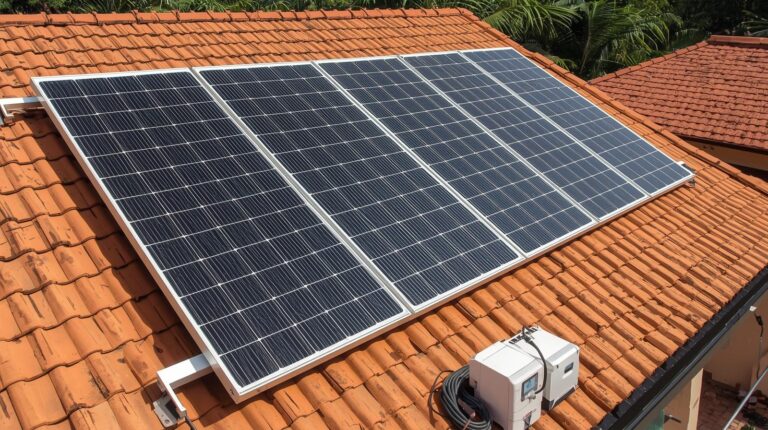In the domain of residential energy solutions, solar power stands out as a particularly intriguing investment for those aiming to maximize long-term savings. The initial cost of installing solar panels is offset by the cumulative benefits of reduced utility bills, tax incentives, and rebates. However, the true extent of these savings can vary based on factors such as geographic location, available sunlight, and local energy costs.
As we explore these variables, one question remains: How can homeowners optimize their solar installations to achieve the best financial outcomes? This discussion seeks to uncover the strategies that maximize the economic benefits of home solar systems.
Key Takeaways
- Opt for a south-facing roof installation to maximize sunlight exposure and energy production.
- Utilize net metering to earn credits and reduce electric bills significantly.
- Apply for federal and state solar incentives to decrease upfront and overall installation costs.
- Regularly clean and maintain solar panels to sustain high efficiency and performance.
- Invest in energy-efficient appliances to lower overall electricity consumption and enhance savings.
Assessing Home Solar Suitability
To determine the viability of installing home solar panels, it is essential to assess several key factors including local sunlight availability, roof orientation and condition, and regulatory constraints.
Understanding the local sunlight availability is paramount; ideal solar efficiency requires 5-7 hours of direct sunlight daily. A professional installer can evaluate solar potential accurately, ensuring maximum energy production.
The orientation of your roof greatly influences the effectiveness of residential solar systems. South-facing roofs are ideal, but east or west orientations can also yield considerable benefits if the panels are angled correctly.
The condition of your roof is equally important. It must be robust enough to endure the weight of solar panels for the next 25-30 years, making this a crucial consideration in your home improvement plans.
Furthermore, local zoning laws and homeowner association (HOA) regulations could impact your ability to install solar panels. It is essential to verify any specific restrictions or requirements that might hinder installation.
Professional installers are also adept at identifying potential shading issues from nearby trees or buildings, which could reduce the system’s overall efficiency.
Exploring Solar Financing Options
Having assessed the suitability of installing home solar panels, homeowners should next consider the range of financing options available that can make this renewable energy source more affordable.
One popular method is through solar loans, which enable the financing of solar panel systems with relatively low upfront costs. This option allows homeowners to immediately benefit from electric bill savings, which typically offset the monthly loan payments.
Additionally, purchasing solar panels outright can offer considerable monthly savings without the burden of interest payments. With an average installation cost of around $25,000, homeowners can expect to save approximately $83 per month over a 25-year lifespan of the system.
The federal solar tax credit further enhances affordability by providing a 30% rebate on installation costs. This substantial incentive can considerably shorten the payback period, which on average stands at about 8.5 years thanks to annual electric bill savings ranging between $1,500 and $2,000.
Furthermore, exploring state incentives can lead to additional financial benefits. Many states offer cash rebates and tax exemptions that can reduce installation costs and improve the overall economics of home solar investments.
Related Post: Claiming the Solar Tax Credit Made Easy: Step-by-Step Guide.
Enhancing Solar Panel Efficiency
Maximizing the efficiency of home solar panels is vital for homeowners looking to enhance their renewable energy usage and increase cost savings. Ensuring that solar panels are installed with a south-facing orientation and a tilt angle mirroring the local latitude is essential. This alignment capitalizes on peak sunlight exposure, thereby improving solar panel efficiency and maximizing energy generation.
Regular cleaning of solar panels also plays an important role in maintaining efficiency. Accumulated dirt and debris can greatly obstruct sunlight, necessitating at least biannual cleaning sessions to sustain system performance. Additionally, homeowners should strategically manage their surroundings to minimize shading from nearby trees and buildings, as even partial shading can dramatically reduce the panels’ energy output.
Incorporating energy-efficient appliances can also boost the benefits of installing solar panels. By reducing overall electricity consumption, these appliances complement the solar system’s capacity to maximize savings. Moreover, continuous monitoring of system performance via solar inverters or dedicated apps is vital. This enables timely identification and resolution of any issues, ensuring that the system maintains peak functionality.
Utilizing Net Metering Benefits
Net metering offers a significant advantage for homeowners with solar panels by allowing them to sell surplus energy back to the power grid, thereby reducing their monthly electricity expenses. Engaging in net metering programs not only minimizes the monthly electric bill but also enhances the financial returns on solar investment through credits for surplus energy. This system is essential for achieving liberation from high energy consumption costs.
Here are key benefits of utilizing net metering:
- Reduced Payback Period: The average payback period can be dramatically shortened, as homeowners recover their initial installation costs faster through savings on their electric bills.
- Increased Annual Savings: Homeowners can achieve significant annual savings, often ranging between $1,500 and $2,000, depending on local energy rates and solar production.
- Optimal Energy Management: Monitoring excess energy production allows for strategic energy usage, maximizing the effectiveness of the installed solar system.
- Sustainable Financial Gains: Credits earned at retail electricity rates for excess solar energy produced during peak hours underscore the potent financial benefits of net metering.
Accessing Additional Financial Incentives
Beyond net metering, homeowners can further reduce their solar installation costs through various additional financial incentives. Central to these is the federal solar tax credit, which allows a substantial 30% reduction in installation costs. This incentive not only lowers initial expenses but also accelerates the return on investment, enhancing long-term savings.
Moreover, many states complement the federal solar tax credit with their own benefits, such as property tax exemptions and cash rebates, further diminishing the financial burden of solar installations. Homeowners can explore these opportunities through the Database of State Incentives for Renewables & Efficiency (DSIRE), a thorough resource that lists detailed state-specific incentives.
Utility companies also contribute to the affordability of solar by offering additional financial incentives or favorable net metering policies. These arrangements permit homeowners to gain credits for surplus energy generated, effectively reducing monthly utility bills.
Another avenue for cost reduction is community-based group purchasing. Such initiatives leverage bulk buying power, securing solar systems at considerably lower prices. This collective approach not only benefits individual participants financially but also fosters community solidarity and collective liberation in energy independence.
Embracing these financial incentives guarantees that solar power is not only sustainable but also economically advantageous, propelling homeowners toward greater energy autonomy and resilience.
Conclusion
In summary, the strategic adoption of home solar panels presents a compelling opportunity for substantial long-term savings. By meticulously evaluating solar suitability, leveraging diverse financing options, and optimizing panel efficiency, homeowners can effectively reduce initial costs and maximize returns.
Additionally, the integration of net metering and other financial incentives enhances the economic viability of solar investments, affirming solar energy as a prudent and sustainable financial strategy in the pursuit of energy independence and environmental stewardship.




